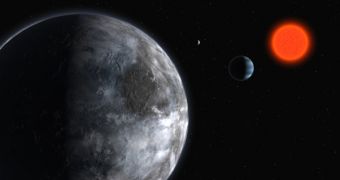As expected, the Gliese 581 system did not disappoint and is now revealing the smallest planet outside our solar system, bringing the total number of planets found orbiting around the red dwarf star to three. When the star was first targeted by astronomers nearly two years ago, only a single planet was detected. The newly found object weighs about 5 times more than Earth, has a rocky surface, and its orbit could allow the existence of liquid water and life.
"The separation between the planet and its star is just right for having liquid water at its surface. That's why we are a bit excited," says astronomer and team spokesperson Stephane Udry of the Observatory of Geneva.
Although astronomers are rather enthusiastic about the fact that the smallest known exo-planet could be habitable, the fact is that for now all they know about it is its mass and the distance to the star it orbits. No data is available regarding the surface temperature of the object, whether or not it has water or if it sustains an atmosphere.
Gliese 518 is a red dwarf star located in the Libra constellation, about 20.5 light years away. All three planets detected around it were found based on measurements involving the wobble of the star, as the planets orbiting it exert their gravitational pull.
"The claim is extremely interesting and the team is very credible," said David Charbonneau of the Harvard-Smithsonian Center for Astrophysics about the discovery made by Udry's research team. The data sustaining the claim has still to be published.
Gliese 518 c, as the new object was dubbed, expands the number of super-Earths found so far to 13, a rather small figure as compared to that of gas giants which count more than 260. This is mostly the fault of the method used to gather data, which measures the radial velocity of the studied star, favoring the detection of large objects. Most of the 13 rocky exo-planets have masses more than 20 times that of Earth.
Gliese 518 c orbits its star from a distance fourteen times smaller than that between Earth and the Sun, although since Gliese 518 is a red dwarf star with a surface temperature 50 times lower than that of the Sun, it would be possible to maintain a climate with a temperature ranging somewhere between 0 and 40 degrees Celsius, close to the temperatures we experience on Earth.
"It's sort of at the 'Goldilocks' distance," says Charbonneau. If Earth had orbited the Sun from such a small distance all the water would have been vaporized. However, having Gliese 518 instead of the Sun would have ultimately led to the freezing of all the water on the surface. The ratio between the star's surface temperature and the orbital distance of the planet appears to be just right to create conditions similar to those on Earth.
The claim made by Udry's research team is somehow premature, says Charbonneau; after all, as earlier said, there is not much known about the new object. It could just as well be a gas giant. However, further observations should clear this matter in the future.

 14 DAY TRIAL //
14 DAY TRIAL //